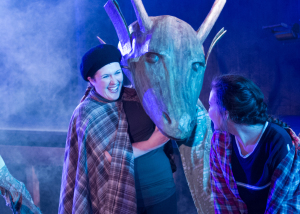‘Loch Ness’ takes us into uncharted waters
by Eric Marchese
Say what you will about playwright Marshall Pailet’s fascination with prehistoric creatures; that milieu has inspired musical theater properties that are about as singular as their subjects.
These include “Triassic Parq,” a 2010 spoof of the reptilian characters in Steven Spielberg’s “Jurassic Park,” and “Loch Ness,” an all-new show whose book Pailet co-wrote with A.D. Penedo.
In early 2013, Chance Theater took a flyer with “Triassic,” with mixed results. The company’s world premiere production of “Loch Ness” yields something richer, deeper and more self-assured while also offering the kind of quirky laughs typical of Pailet.
Maybe it’s because this time around, our focus is on human characters who are flawed. Those flaws are on display because of how the characters choose to regard the loch-bound sea creature known as Nessie.
In the early 1990s, Dr. Thomas Westerbrook (Jackson Tobiska) has seen his wife, a mother to 12-year-old daughter Haley’s (Julia Cassandra Smith), disappear. Neither has done well in dealing with the loss, and it has damaged their relationship.
Having spent every last penny in trying to find his wife, scientist Westerbrook is forced to take the only commission offered him. Leana Callaghan (Angeline Mirenda) hires him to lead an expedition vessel onto Loch Ness, then locate and document Nessie’s existence.
The mission brings numerous dramatic conflicts to the fore that are given considerable weight by Pailet. At the helm as director, he’s careful to use the show’s laughs only as comic relief and not a goal in themselves.
That places more emphasis on the friendship that gradually develops between Haley, who feels alienated from her dad, and Nessie (Katie Brown), whose very existence has grown to legendary proportions.
As prominent are the show’s musical content and its visuals. The songs, through Mark Sonnenblick’s music direction, offer windows into the thoughts and feelings of the story’s characters. Kelly Todd’s choreography expands upon those elements without overshadowing them.
The songs in “Loch Ness” are certainly more engaging than those of “Triassic Parq,” and its characters are a lot more personable – eccentric and very human. Their flaws make for quirkiness that triggers audience laughter. Lending credence to the characters are some lyrics being sung in what sounds like authentic Gaelic.
Part of “Loch Ness’” dry humor is generated by the script, the rest by Pailet’s cast members. To wit, in Peter Pan fashion, Brown’s Nessie needs a human (read: Haley) to believe in her, prompting the Descartes-like statement “You think, therefore I am.”
The show’s visual aspects also take on added significance. Fred Kinney and Megan Hill’s scenic design combines the deck of the exploration vessel with the vastness of the lake itself. While the expected effect of the water’s fogbound surface is never fully realized, we’re still convinced we’re in uncharted waters both geographically and dramatically.
Kinney and Hill’s puppet design and Baxley Andresen’s puppet mechanics and fabrication bring life to Pailet’s focal non-human character. Brown may be the voice and personality of Nessie, but that guise is cemented by the life-size head, neck and tail of the mythical creature, operated throughout by Brown and other cast members.
No less vital is the script’s skillful handling of Westerbrook and Haley’s coming to terms with each other. In Jackson’s Westerbrook we see a stiff-necked martinet struggling as a single dad. In terms of hard-headed stubbornness, he finds he has met his match in Haley.
Mirenda’s Lady Callaghan is wealthy and self-possessed, her speech colored with a strong Scots brogue. Brown delivers a scarily vulnerable Nessie, and her lilting Scots accent is in fine contrast to Smith’s crisp British diction, while Matt Takahashi, as town constable Angus Ogilvie, plays his pungent burr for laughs. The outspoken Highlander called The Oiler (Corky Loupe) also uses Scottish inflections for comedic effect.
The show puts other colorful accents on display: well-educated British (Dr. Westerbrook, Haley and C.J.) and French (ship’s crew members Pierre and Éclair, played respectively by Keaton Williams and Gina Velez.
At its core, “Loch Ness” is about how Haley and Nessie bond, to the benefit of both, and Smith and Brown pleasingly underplay their characters. Their friendship allows Pailet and Penedo to explore the dynamics at work between two sets of mothers and their daughters: Haley and her mom, Nessie with hers.
Unlike much new musical theater, “Loch Ness” is a charming, pleasingly quirky, wholly original concept. Its fine staging at Chance shows that theaters taking a chance on a new, unproduced play can strike it rich.
Leave a Reply


